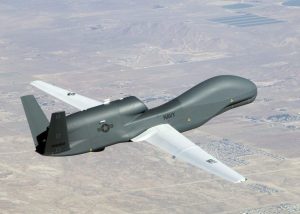

The U.S. Navy Drone surveying the ocean. Looking for the NextWave. Wu Hu!
Hey Wray let’s make it easy fore U. CTO EE. It’s so much more than the Tsin Tsin Road.
SMILE! Find Judge Advocate. Find Affirmed.

“Everybody’s gone surf in’…Surf in’ USA…”

CNN: Two Fox News hosts question Trump’s comments about Iran: ‘This just doesn’t add up’.
ANSWER IS: Shure it does.
And the $240 million dollar bill which includes all the upgrades needs to go to…WHO knows…
“Poor Shep and Chris. They walked right into it. Such a thing. GO figure. &.”
– The Shark and Sparky the Clown
Trump Hits FOX News at PA Rally: “Something Very Strange Is Going On”
– Donald Trump, President of The United States of America
Mueller, Comey, McCabe, Strzok, Wray…This is your Fools Brought In fore a reason…still Not Sure Dunno.
It is truly amazing when a significant piece of intel given to DHS, the FBI, and the Intel community, and after nothing was done, it winds up on a jihadi website and in perfect english. How could it be…WHO knows…Now back to that airplane hanger at Ft. Hood. U.O.
What is the DOJ, the FBI, the CIA, the NSA, the Intel Community, the Department of State, and Congress hiding?
SUA has proprietary intel concerning the greatest crimes ever committed against the American people.
By Jackie Wattles, CNN Business
New York (CNN)Fox News hosts Chris Wallace and Shep Smith challenged President Donald Trump’s comments about when and why he decided to call off a strike against Iran.
How The U.S. Could Respond After Iran Shoots Down A $240 Million U.S. Drone
By Mark Cancian
Tensions continue to escalate in the Persian Gulf as the Iranians down one U.S. drone, shoot at another and, likely, sponsor attacks on tankers and a Saudi airport. Let’s take a look at the most recent incidents and what they might mean for the future. Will there be a war?
What happened? Early Thursday the Iranians used a surface to air missile to shoot down a U.S. drone just outside the Straits of Hormuz. The Iranians posted a video that purported to show the shootdown, and the United States acknowledged that it had lost a Broad Area Maritime Surveillance drone (BAMS-D). The Iranians claimed it was in their territorial airspace while the United States claimed it was in international airspace. Under international law, it’s a critical question, and, eventually, there will be an answer. The United States will likely salvage the wreckage, as it has with recent aircraft crashes, and the location will show where the drone actually was. However, that will take many weeks and likely be of historical interest, rather than helpful in resolving the current crisis.
What is this BAMS-D drone? This is a Navy prototype version of the Air Force RQ-4 Global Hawk. The Navy’s fully developed version is called the MQ-4C Triton and is just entering production. These are very large unmanned aircraft. The wingspan is 132 feet, comparable to a civilian airliner. (For comparison, a Boeing 757 has a wingspan of 124 feet.) The drone is designed for intelligence, surveillance, and reconnaissance (ISR), the Pentagon term meaning that it has sensors to find things on the earth surface. The Navy’s version focuses on the sea, whereas the Air Force version focuses on land. Here’s how DOD describes the Navy version: “The MQ-4C will provide the Navy with a persistent maritime ISR capability. Mission systems include inverse Synthetic Aperture Radar, Electro-optical/Infra-red Full Motion Video, maritime moving target detection, Electronic Support Measures, Automatic Identification System, a basic communications relay capability, and Link-16.” Because of their size, BAMS-D and Triton are land based.
BAMS-D is not stealthy, is unarmed, flies relatively slowly, and has essentially no defensive systems. Its only defense is to fly high, at 60,000 feet. Because of its vulnerability, it is not designed to operate in a contested area. Its great advantage is that it can fly for over 32 hours continuously, far longer than any human crew could endure.
So, what was it doing there? Although the Pentagon has not stated what the mission was, one presumes that it was watching for more tanker attacks. Four ships were attacked in May and two more last week. If the U.S. could catch whoever was doing the attacks, presumedly Iran, then it might be able to thwart future attacks and have the evidence needed to convince domestic and international audiences of Iran’s culpability.
Does this thing really cost $240 million? Yes…and no. Because DOD weapons are custom-built, they don’t have price tags like equipment does in the civilian world. Systems have many possible costs depending on what is included and what the number is used for. Thus, different commentators have cited different costs for this aircraft, for example, $120 million or $180 million.
Since BAMS-D is a version of the Air Force RQ-4, we can use the RQ-4’s official acquisition report, called the Selected Acquisition Report, to calculate a cost for BAMS-D. This report shows an average procurement cost over the whole program of $122 million in FY 2015 dollars or about $130 million in FY 2019 dollars. That excludes the research and development costs, which are mostly sunk at the beginning of the program. If those were included, the cost per aircraft would increase to about $240 million (FY 2019 dollars). To make things even more complicated, there is something called the “flyaway cost,” which is the cost of a system coming out of the factory without some of the support elements in the “procurement” cost. The “flyaway cost” of a new MQ-4C replacement for the lost BAMS-D is a bargain, at $102 million (FY 2019 dollars).
No matter which cost you pick, however, this was an expensive system. It is a very large aircraft with many sophisticated sensors on it.
What were these other attacks? Apparently, Iranians also shot at another drone last week, an MQ-9 Reaper (replacement for the legendary MQ-1 Predator), but missed. That it missed is likely because Reapers are much smaller than the MQ-4C and thus harder to hit. They are also much less expensive, costing about $30 million. The Reaper drone, like the MQ-4C that was shot down, was likely looking for perpetrators of the tanker attacks and was probably the source of the video about Iranians removing mines from the attacked tankers.
Also last week a group of Iranian back Yemeni rebels attacked a Saudi airport with cruise missiles, one of a series of such attacks. The bottom line is that these drone and tanker attacks are not isolated incidents but part of the campaign by Iran to put pressure on its major enemies, the United States and Saudi Arabia, and, indirectly, on the Europeans, Japanese and others to get relief from U.S. sanctions.
What’s going to happen next? The Iranians are signaling that they will not accept the U.S. imposed sanctions passively. They are striking back as they always have: asymmetrically and in the “gray zone.” Asymmetrically means they are not meeting U.S. strength head-on and the gray zone means they are maneuvering in the space between war and peace. Likely, the Iranians will continue to initiate “incidents.” By maintaining some deniability and not injuring human beings, the Iranians have been very clever in keeping these incidents below the level where the United States would respond with force.
At some point, the Iranians may cross these lines either by injuring an American or by being caught red-handed in conducting an attack. Then, the United States would almost certainly respond with force. This happened in the 1980s when the United States caught the Iranians laying sea mines in the Persian Gulf and retaliated by sinking half of the Iranian Navy.
The U.S. has the capability in theater now to conduct a retaliatory strike, likely against the air defense battery that shot down the drone. According to the New York Times, an attack on Iranian radar and missile batteries was prepared for Thursday, but the operation was cancelled. Strikes could also be directed against Iranian naval capabilities that might have carried out the tanker attacks. The U.S. does not have enough assets in theater to conduct an extended air-naval campaign, even with the additional thousand troops being sent. It certainly does not have the capability to conduct any ground campaign against Iran.
More likely, however, is something non-kinetic. The president is reluctant to get into a shooting war, having campaigned against such involvements. Instead, the United States might take some covert action like the cyber-attack that was allegedly recently conducted against Russia. It might start escorting ships and aircraft through the Straits of Hormuz. The NATO allies and Japan might be willing to support such an action.
Unfortunately, the situation is not stable. Most likely, there will be additional incidents within a week with each carrying the risk of escalation. Last August, I wrote a piece looking at indicators of a possible conflict (Is The US Going To War With Iran? Five Indicators To Watch For). Three have occurred (“increased naval activity,” “Iranian complaints about reconnaissance flights,” and “increased security at regional U.S. bases”).
China hacked US Army transport orgs TWENTY TIMES in ONE YEAR
FBI et al knew of nine hacks – but didn’t tell TRANSCOM
U.S. Attacks Iran With Cyber Not Missiles — A Game Changer, Not A Backtrack
From 2014 and earlier…OOOPS…It is re levant.
China targets own operating system to take on likes of Microsoft, Google
Article
“I think we missed the BAMS-D thing and finding Omar…”



Now back to MAR-A-LAG-O. All along the watchtower. It’s not the Hawaiian but it will do.





